| Reviews & Columns |
|
Reviews DVD TV on DVD Blu-ray 4K UHD International DVDs In Theaters Reviews by Studio Video Games Features Collector Series DVDs Easter Egg Database Interviews DVD Talk Radio Feature Articles Columns Anime Talk DVD Savant Horror DVDs The M.O.D. Squad Art House HD Talk Silent DVD
|
DVD Talk Forum |
|
|
| Resources |
|
DVD Price Search Customer Service #'s RCE Info Links |
|
Columns
|
|
|
Edison - The Invention of the Movies
While the invention of motion pictures can't be totally credited solely to Thomas Edison and his team, Edison and his group were indisputably essential in the development of the movies. Bringing together a series of inventions; the camera, a viewing machine, the creation of long strands of film, the machine to punch sprocket holes in the film along with a method of developing the long reels, the Edison's company made the moving picture a commercial reality.
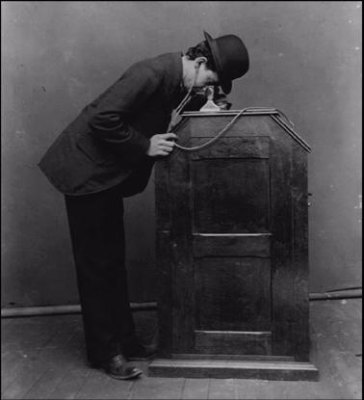
Movies started out as a fad where a single person could watch a short scene on a coin operated machine. When this fad died, Edison helped pioneer the projecting of films so that audiences could simultaneously watch the same show. I addition to technological achievements, Edison's company produced the first blockbuster hit movie (The Great Train Robbery, included in this set) and the first serial (What Happened to Mary? (1912) incorrectly labeled as What Happened to Jane in the notes on disc one. Unfortunately a chapter of this innovative type of film is not included with this set.) Edison's company, largely thanks to director Edwin S. Porter, also helped develop a 'language' of film and establish the way stories would be told on the screen. Yet for all of these achievements, by the end of the teens the movie world had passed Edison's company by. After losing money for three years, mainly due to low quality films and insufficient volume of product in addition to distribution difficulties, Edison sold off his motion picture company.
All told, Edison was in the motion picture business for nearly thirty years, from 1888 to 1918. This was a period that saw dramatic changes for moving pictures; method of exhibition, length, content and even the way that stories were told all underwent major evolutions during this period. Though today his studio's output is generally glossed over, the history of the Edison studio is in a large part the history of early film.
The Films:
Kino, in association with the Museum of Modern Art, presents a lavish four DVD set that traces the evolution of film through the movies that the Edison Company released. There has never been such a large group of Edison films brought together before. In all 140 films are contained in this set, interspersed occasionally with introductions by film historians. From early test films printed on cylinders in the late 1880's and loops that were shown on single viewer kinetescopes, to shorts meant to be projected in vaudeville shows and eventually feature length films, this set charts how movies changed and developed in their early years, going from novelty to American institution.
The movies contained on these DVDs are arranged in chronological order, starting with a couple of early experiments done at the Edison lab, and soon progresses on to a large number of shorts (50 feet in length running about 20 seconds) shown in kinetescopes. I found these short movies very interesting. They not only provide a glimpse of what life was like 100 years ago, but they also show what people thought was entertaining and worth paying for. (Or at least what Edison et al thought people would find interesting. ) Many of these films involve dancing ladies or athletic events. These are simple single shot films with no attempt at narrative.
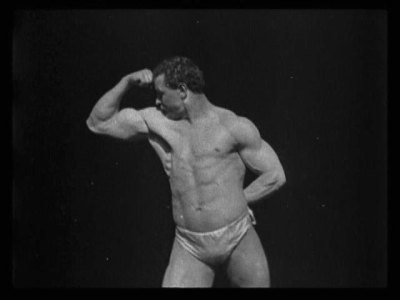
When you compare these with the Lumiere or Meles films that were made just a few years later, they are drastically different. As where the French productions mainly contained short 'slice of life' scenes, sex and violence were predominate in the Edison films. There were films of men boxing (a sport that was illegal in most states at the time), roosters and cats fighting (the latter with boxing gloves,) a reenactment of the beheading of Mary Queen of Scotts, and many films of women belly dancing and moving suggestively.
Around the turn of the century, projection becomes more the norm, the length of the movies increased too. Length and the method of exhibition were not the only, nor were they the main, things to change with film. The most important development was in the subject matter. More real life 'news' type reels are produced. Firemen rushing off to a fire, troops landing in Cuba, and scenes of devastation from the Galveston, TX hurricane start to pop up. This set includes many of these minute long shorts, the most interesting ones showing street life in New York.
The films also start to have more narrative to them, telling simple stories, or portraying a single gag. One of the important early film directors was Edwin S. Porter. Previously an exhibitor, he joined Edison and soon became their lead director. Porter started experimenting with story telling in some of his films. One of his important films is 1903's Life of an American Fireman. Firefighting had been a theme in movies since the early kinetescopes, and in this movie Porter splices together nine shots to tell the story of a fire rescue. From the firefighters in their firehouse, to getting the alarm and rushing to the scene, this picture tells a story. Even more interesting is the way the rescue scene is depicted at the end. First the action is shown from the inside, with a fireman getting a woman and her child and helping them out the window to a ladder, then the same scene is shown again, but from the outside. This method of parallel story telling would become the standard practice in films for half a decade.
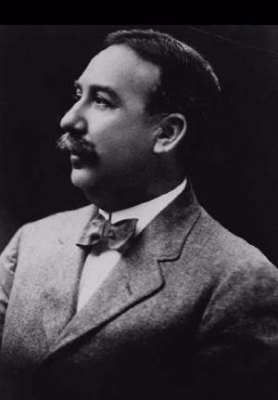 |
| |
Porter, along with other directors at other studios, realized that the public wanted longer films, and he gave them what they wanted. In the early years of the 20th Century, ten minute films were routinely being produced. One such early Edison film is Uncle Tom's Cabin, which uses a traveling troupe of actors and their sets. Porter directed this one again. Like many films of this time, the director assumes that you are familiar with the story (a safe assumption for the time) and presents some of the bigger scenes from the story, rather than trying to adapt the entire novel in just a few minutes.
One of the highlights of this set is the collection is Porter's 1903 The Great Train Robbery. The first really big hit movie, this film is a highpoint in very early cinema. Here Porter tells a new story, one the audience didn't know before entering the theater. The plot is simple but effective: A group of crooks tie up a station agent and then rob a train while it is stopped for water, and then are chased by a local posse. This movie is stunning when compared to the films that came before it. The story is linear and easy to follow, there is action and the chase scene at the end is even suspenseful. One of the very first films to tell an entire story, The Great Train Robbery holds up well even today. The print used for this collection is excellent, and is the only print still surviving that has the original tinting and hand coloring. A wonderful looking film.
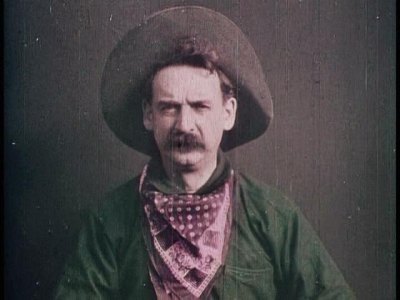 |
| |
Following the success of The Great Train Robbery, Edison's company released more fiction films than it previously had, though they still produced a lot of non-fiction/real life films.
By 1907, nickelodeons (small store front theaters where one could see movies projected for a nickle) were extremely popular, and they had an insatiable demand for film. Just about anything would sell, and Edison turned out a good number of ½ reel (10-13 minutes) films during this time. This was also a turning point for Edison's company. With the easy money to be made making films (along with the courts ruling that Edison's patents were too broad, effectively breaking his near monopoly) a lot of competition popped up. While other studios like Biograph were developing a more linear from of story telling, the Edison films weren't changing with the times. Much of Edison's output was still using a parallel format of story telling, where the action is scene twice from different vantage points, and this method of story telling was starting to become dated, though they were still selling well, the critics were generally harsh. One of the interesting movies from this period is 1905's The Little Train Robbery, where Porter spoof's his own landmark film by filming it with children and using miniature sets. A funny take-off.
Another interesting movie is Rescued From an Eagle's Nest (1908,) with future director D. W. Griffith in his first staring role as the father who rescues his child from an eagle. Even at this late date Edwin S. Porter was still using the parallel style of editing that he created in 1902-03. Advances had grown beyond that by this time, and the sequential showing of the same scene really drained any suspense out of the action. It is ironic that the star, D. W. Griffith, would go on to become one of Hollywood's eminent directors by cross cutting the action, the opposite of Porter's style, to create a heightened sense of tension.
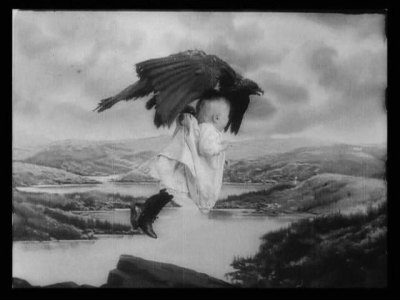
Edison continued to turn out one reel comedies and short moralistic dramas through the teens. Most of these were uninspiring efforts; safe films that no one could object to, but that lacked creativity and passion. Not all of Edison's later films were pedestrian though. The output form the later years had some very interesting movies including The Unsullied Shield. In this moralistic play, a young man is lectured by portraits of his ancestors on his responsibility to the family name. The use of double exposures to show the man inspiring scenes, though not new or unique at the time, did work very effectively.
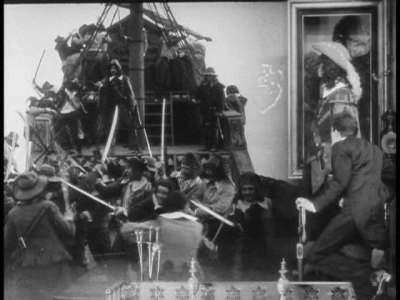 |
| |
In the later teens, Edison realized, too late, that feature films were what was wanted. They released a few feature films, but many of them lost money. With World War One raging in Europe, those foreign markets, once a source of profit for Edison, were closed. This, combined with the falling projector sales caused Edison to sell his film company in 1918. This set ends with what is most probably Edison's last release, the feature length film The Unbeliever. (The only feature presented in this set.)
A moralistic war picture, The Unbeliever is reminiscent of many of the propaganda pictures that were made during WWI. Phillip Landicutt (Raymond McKee) is a young man who has had a privileged upbringing. He looks down at the lower classes, but after joining the marines and being sent to France, he discovers that all men are equal.
Though this isn't a standout drama, it is good. The direction by Alan Crosland, who would go on to direct The Jazz Singer, is solid and typical for a film of the time. The highlight of the film is Erich Von Stroheim, who gives a wonderful performance as a German Officer who delights in killing old women and children.
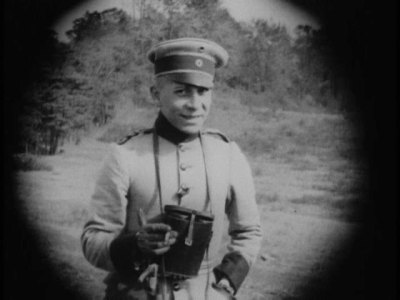
As I mentioned earlier, this set also contains comments by film historians that are intersperse among the films. (There is the option to play the movies with these comments.) Some of the interviews that were included were a little verbose in parts. Some of them tended to stray off on tangents, such as which film archive held which film, and who restored certain shorts in the 60's, but generally they were informational and a nice addition. I was particularly interesting to find out how "The Kiss" effected the lives of the actors who starred in it, John C. Rice and May Irwin.
It is ironic that Edison's film business ultimately failed because of their inability to change. Even as other studios were putting their efforts towards feature length films and like The Birth of a Nation, Edison was still churning out one reel films. This set is a wonderful collection though, collecting decades worth of important films. Watching this set it is easy to see how movies changed in the early years, growing more complex and elaborate as time goes on.
The DVD:
This four disc collection comes in a fold out holder set in a slipcase. Unfortunately, there is not a printed set of notes included. The copious notes are on the first disc in .pdf format, and can be printed out from a computer equipped with a DVD-Rom drive.
The main critique I have of the set deals with the way the films are presented. Viewers have the choice of playing all of the films either with, or without the accompanying interview segments, or by selecting a single film from a sub menu. If you select a single film, it will play and then bring you back to the film title menu. The problem with this is that it is difficult to continue watching the series of films from a midpoint. What you have to do is start the series from the beginning and chapter skip to the section where you left off. This can take a while since there are about 100 films on the first disc. I loved these movies, but I did find it hard to watch an entire three hour disc at a single sitting. It would have been better if the film selection menu worked like the chapter selection does on a regular movie DVD.
Audio:
The audio track for these films are newly commissioned pieces preformed by a variety of musicians. The music fit the pieces well, though I actually preferred listening to the 50 ft earliest films without musical accompaniment. (They were too short for the music to really set a tone or feel, but that's just me.) All of the soundtracks were free of distortion and other audio defects.
Video:
Kino did a splendid job with the video aspect of this collection. They have resisted the temptation to do a quick and dirty 'cleaning up' of the video with digital filters, I'm happy to announce. Digital noise reduction and the like can make a picture appear cleaner, but it also softens the image, and I'm glad these weren't altered digitally.
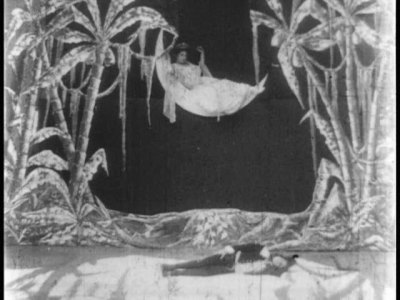
Some of the films in this collection have gone through restoration, but many of them haven't. It is amazing that these exist at all, since most of the films are over 100 years old and printed on film stock that decomposes fairly quickly. Almost all of the films show some sign of print damage, and there are some instances where the emulsion has started to decompose, but this is to be expected. In general, the image is sharp and bright and a pleasure to watch.
Extras:
This set has a nice set of extras, all on the first disc, with a single expection. There is an interesting a text piece about the DVD, several supplemental interviews, and a photo gallery that has a wonderful set of behind the scenes stills. There is also a series of kinetophone recreations. The kinetophone was an early attempt (1895) to add sound to kinetoscopes. Viewers would put on crude head phones and listen to musical tracks while watching the film through the kinetoscope's peephole. This section takes some of the films presented on the disc and adds the audio from Edison cylinder recordings from the period to recreate the effect of this early sound experiment.
There is also a minute long promotional video The Meeting of the Motion Picture Patents Company where Edison greats the other patent holders on the third disc.
Final Thoughts:
This is a truly impressive collection. This wide variety of films that span nearly 30 years wonderfully chronicles the changes that motion pictures went through in the early years. The evolution of story telling technique is very well illustrated through these films. A set that all students of early cinema should be sure to obtain. Highly Recommended.
|
| Popular Reviews |
| Sponsored Links |
|
|
| Sponsored Links |
|
|
| Release List | Reviews | Shop | Newsletter | Forum | DVD Giveaways | Blu-Ray | Advertise |
|
Copyright 2024 DVDTalk.com All Rights Reserved. Legal Info, Privacy Policy, Terms of Use,
Manage Preferences,
Your Privacy Choices | |||||||













